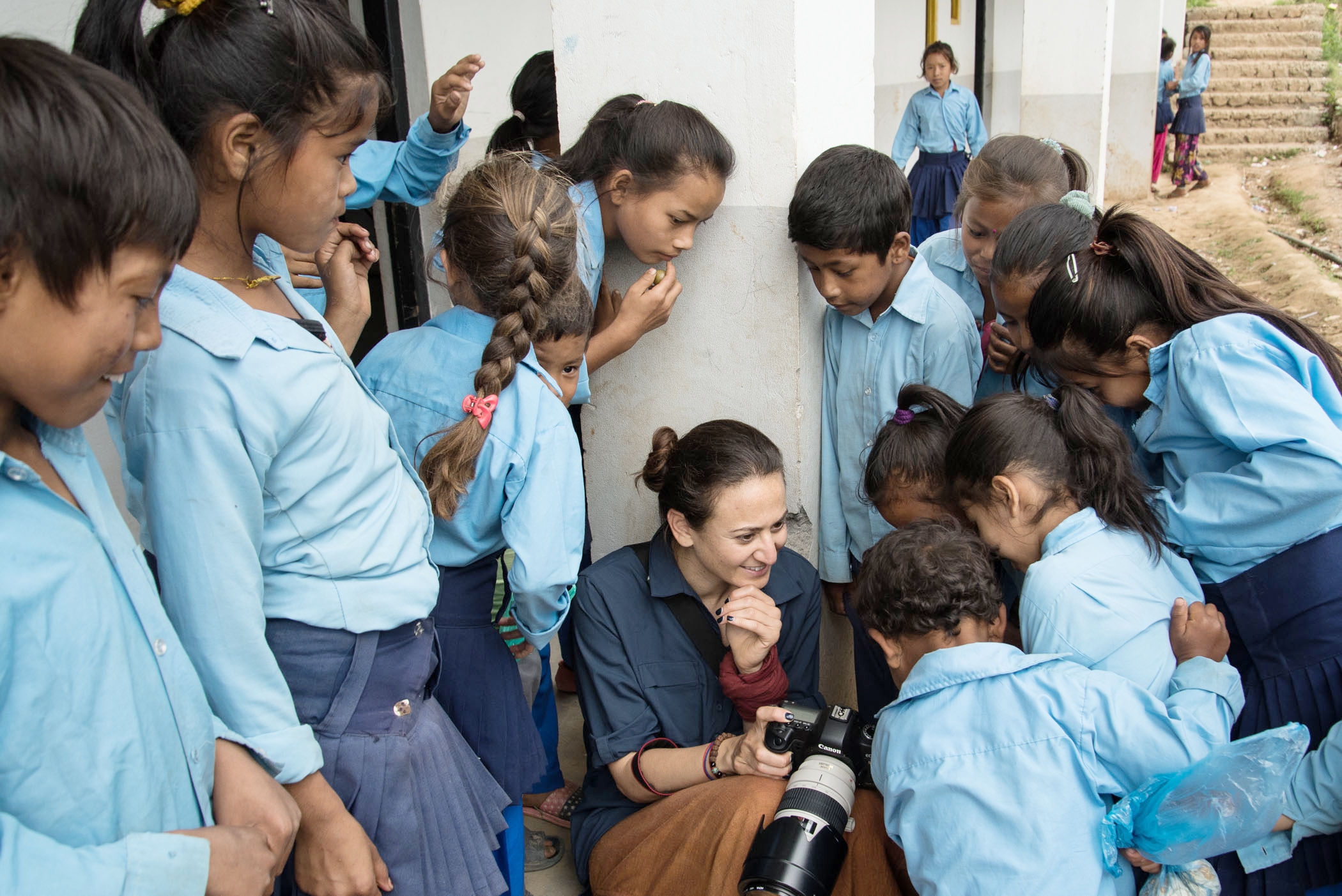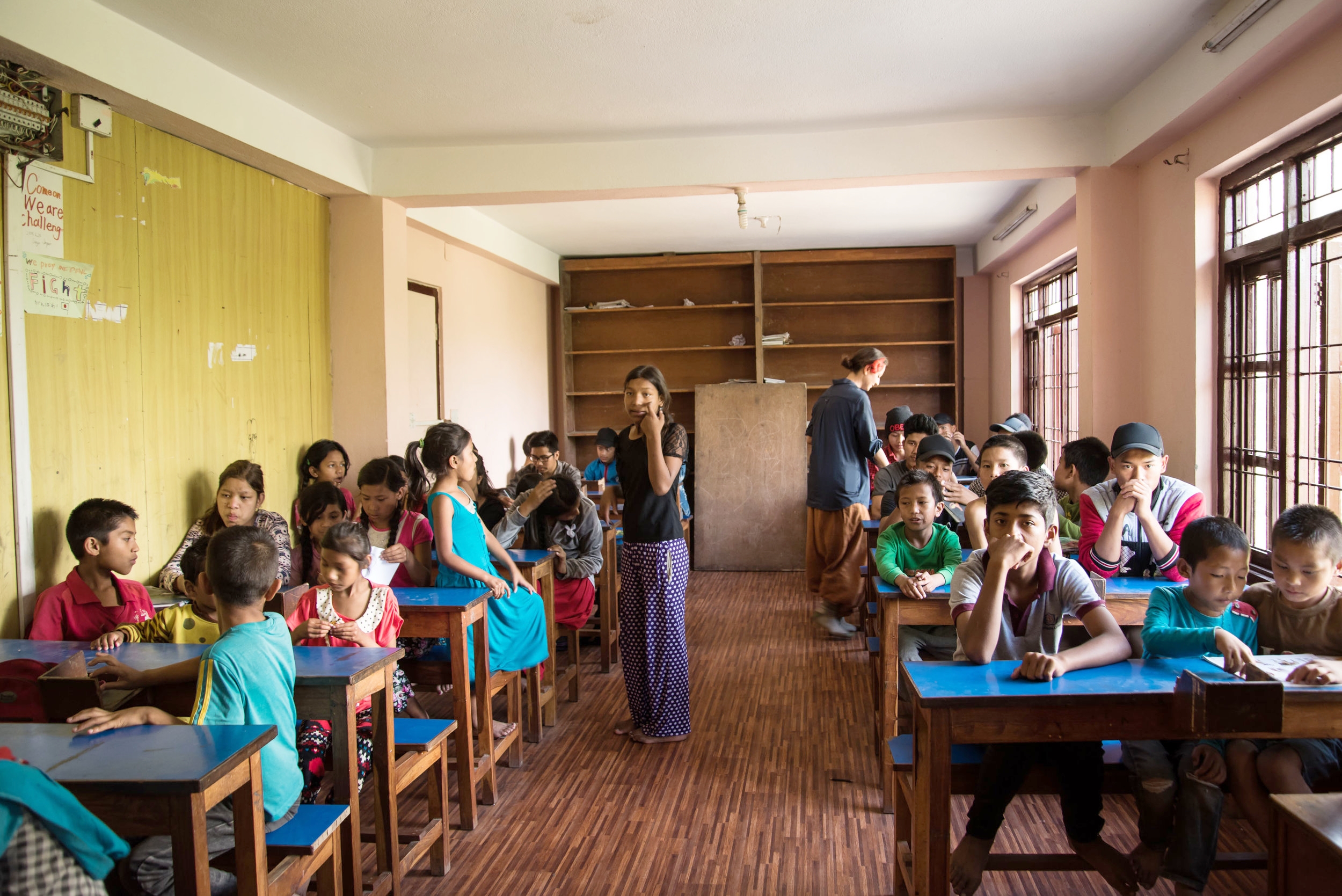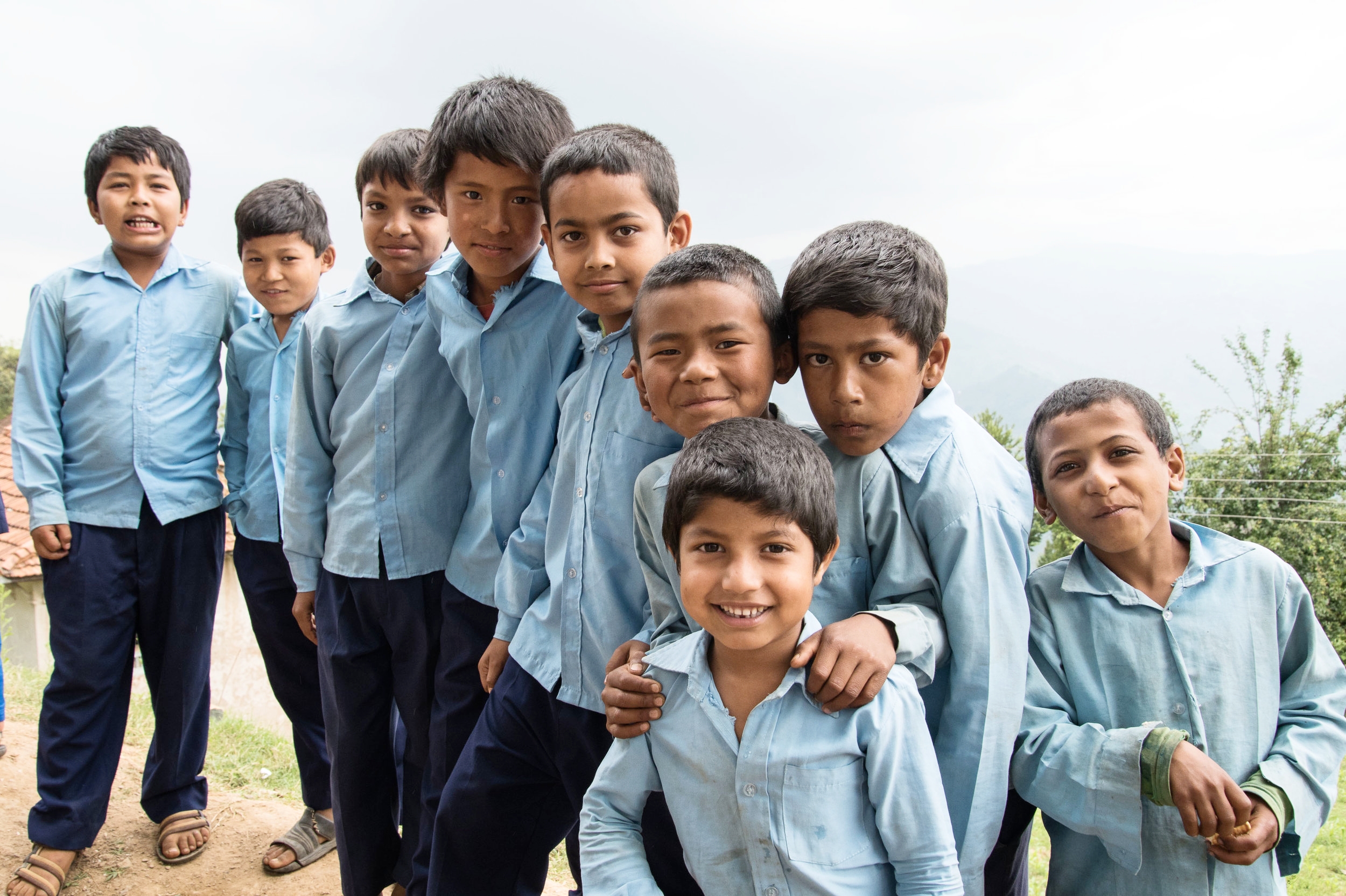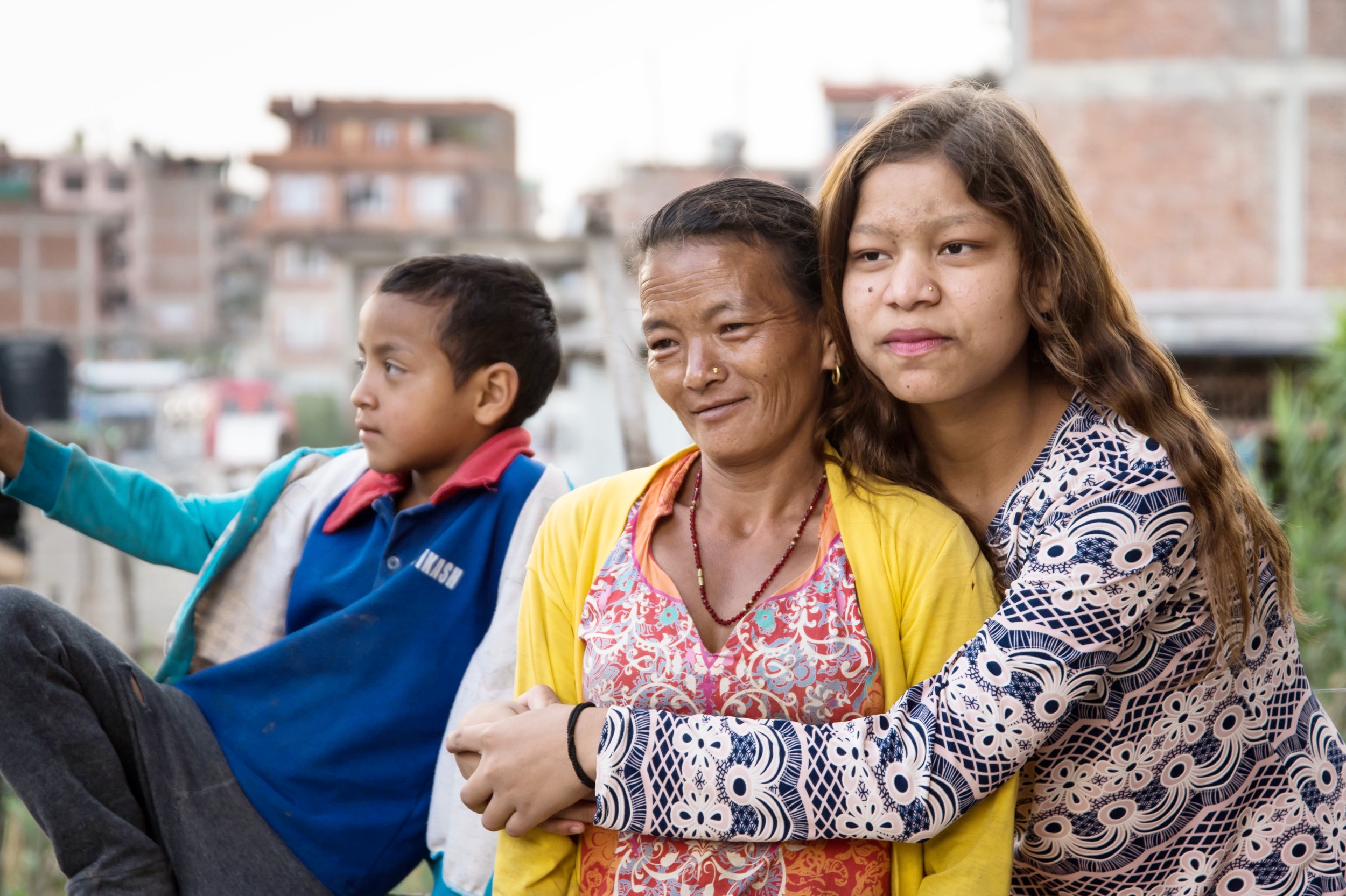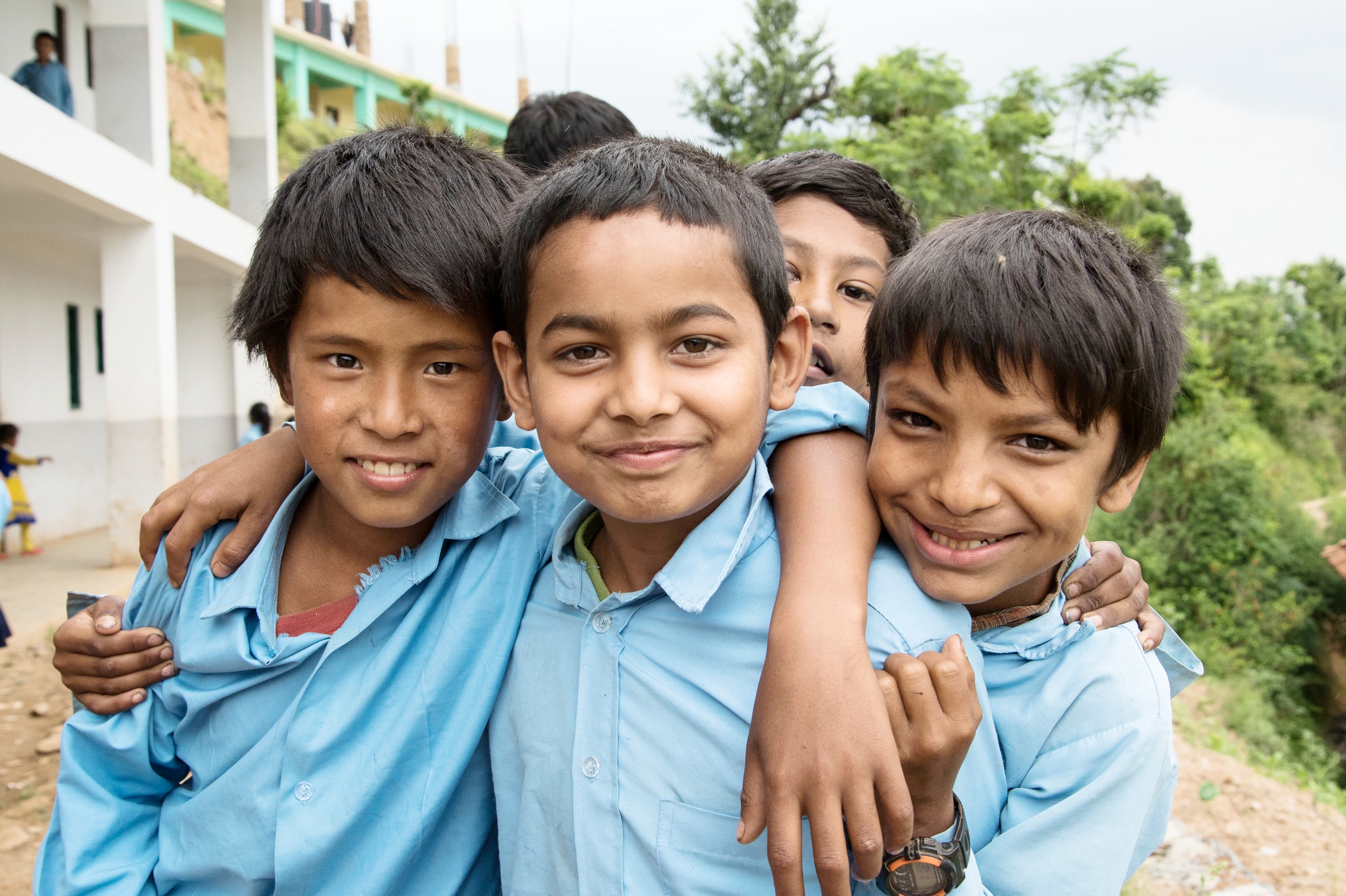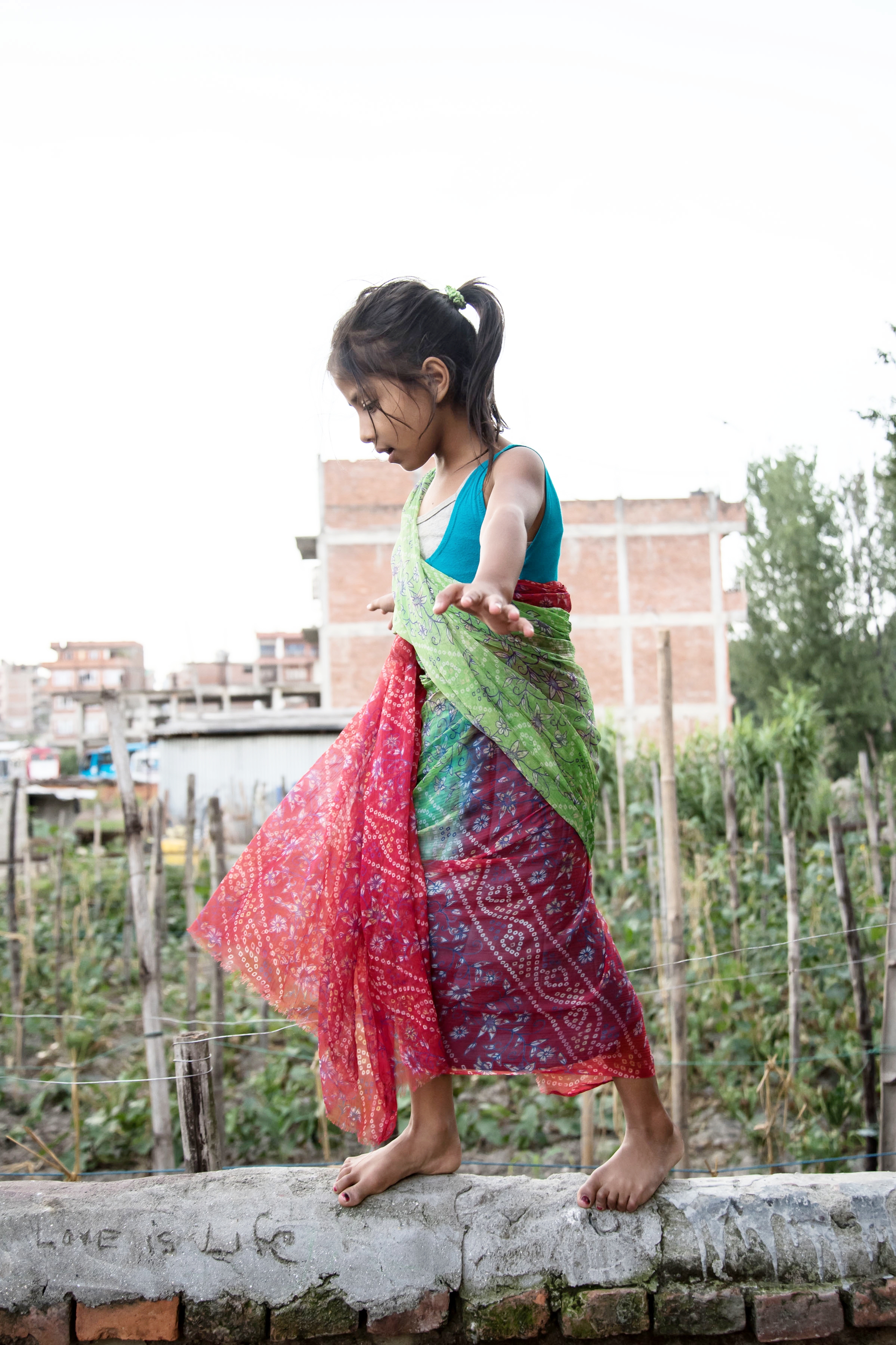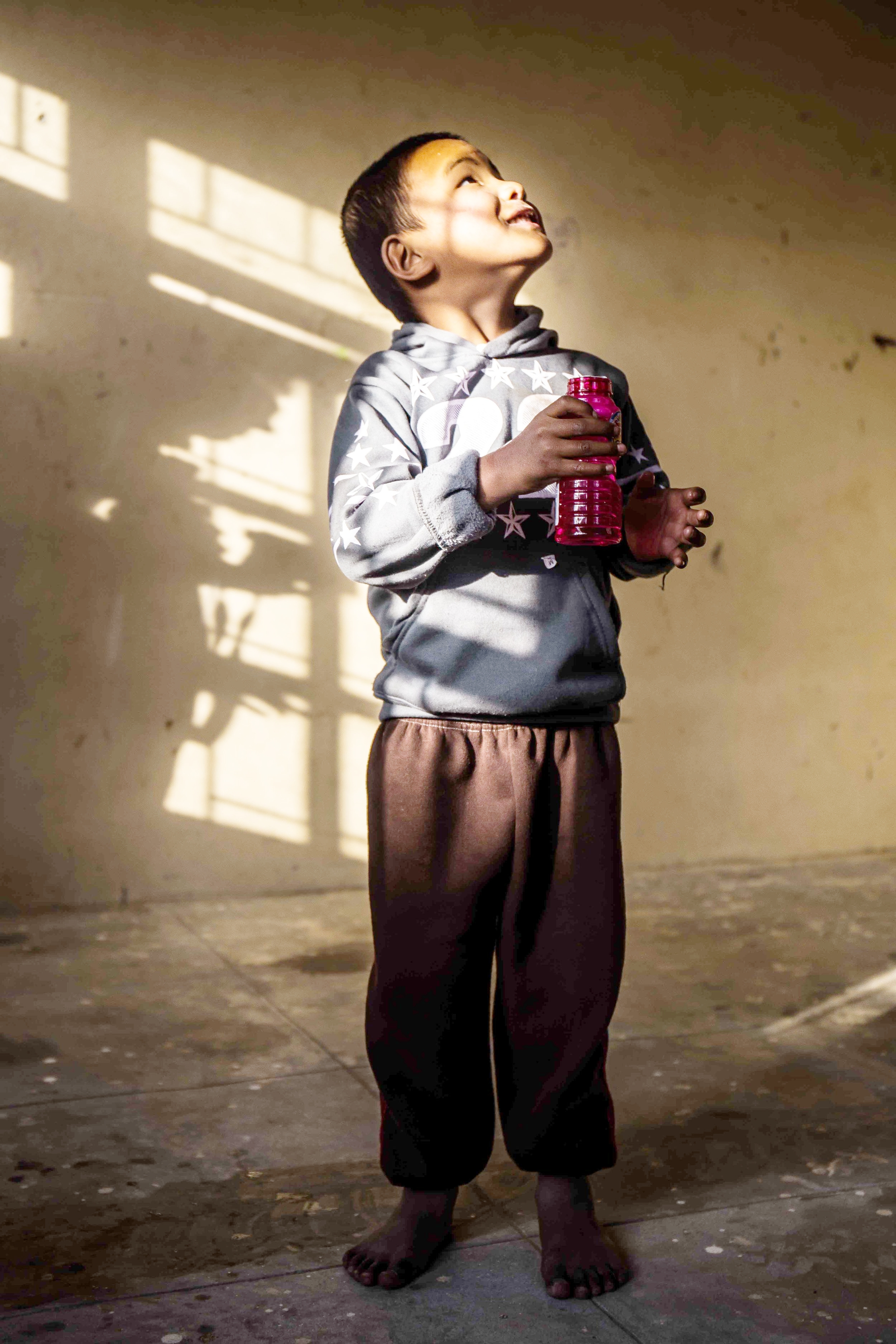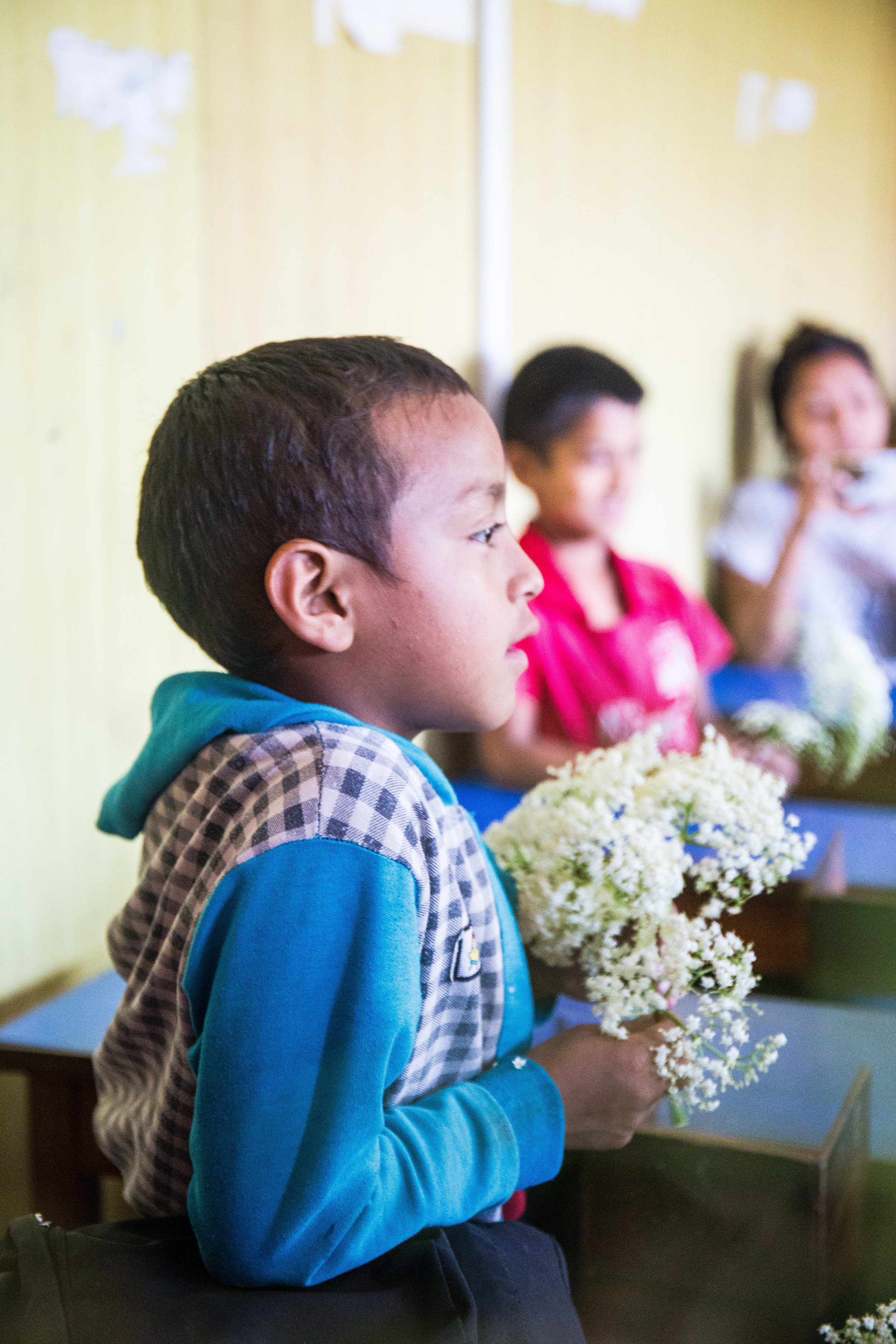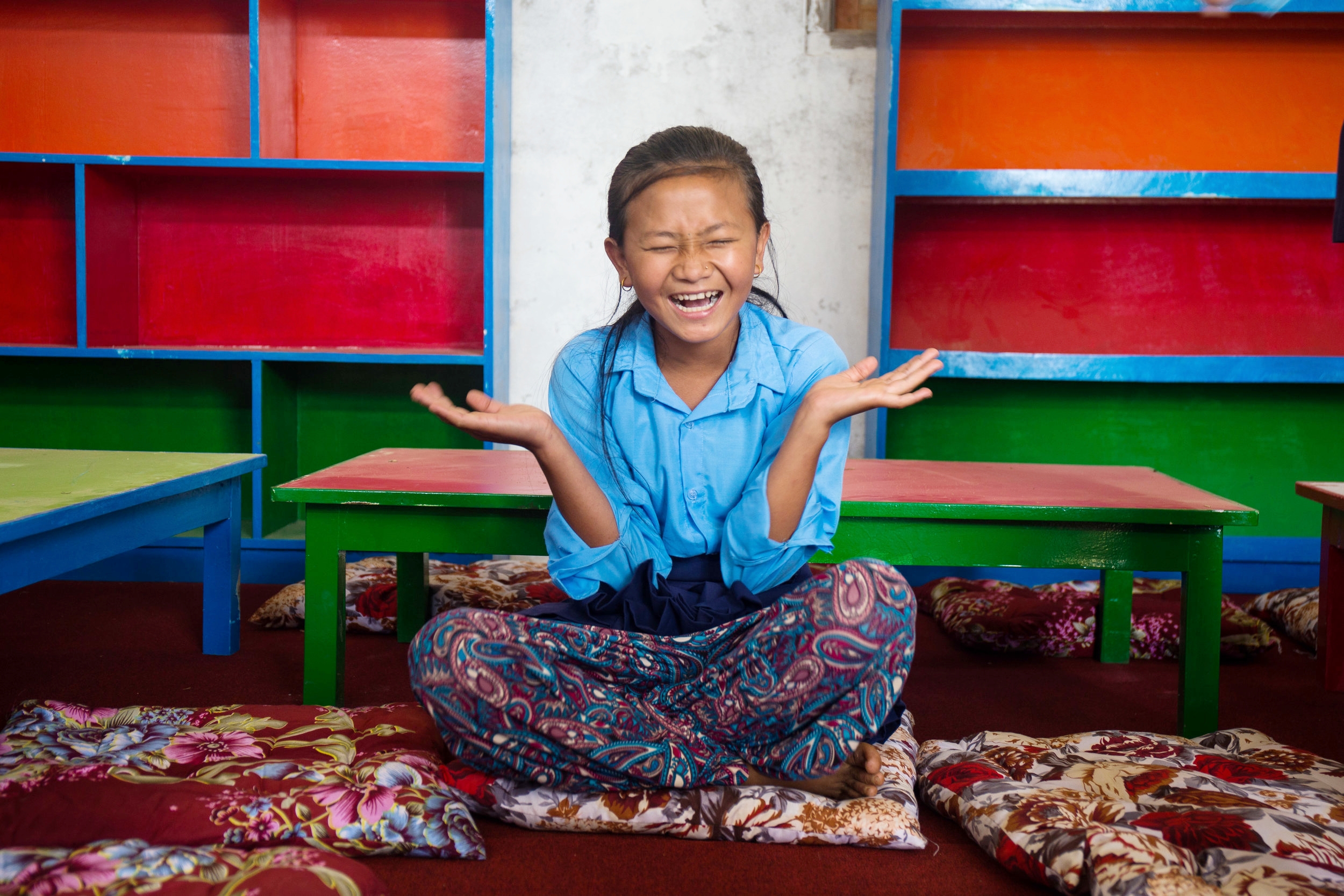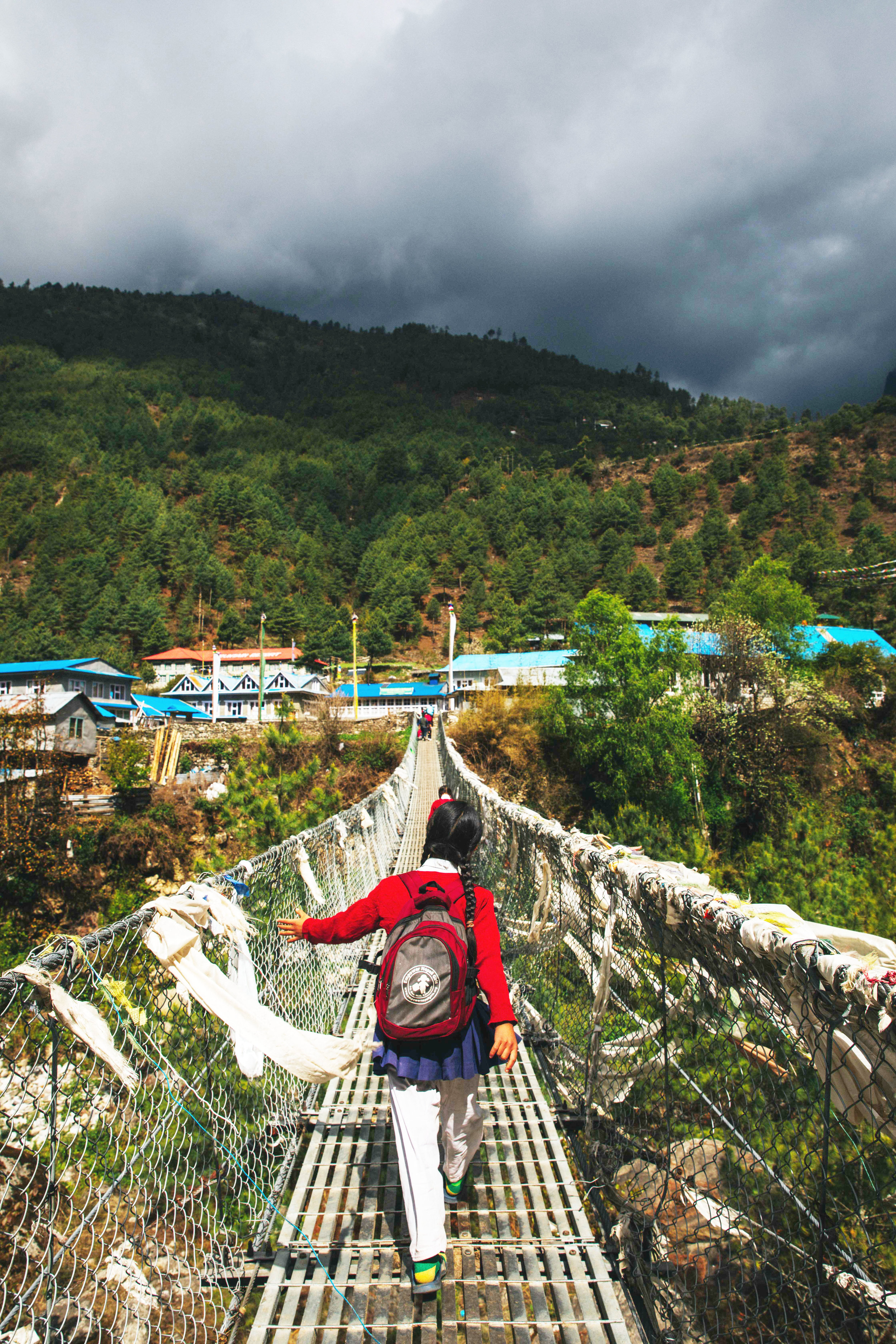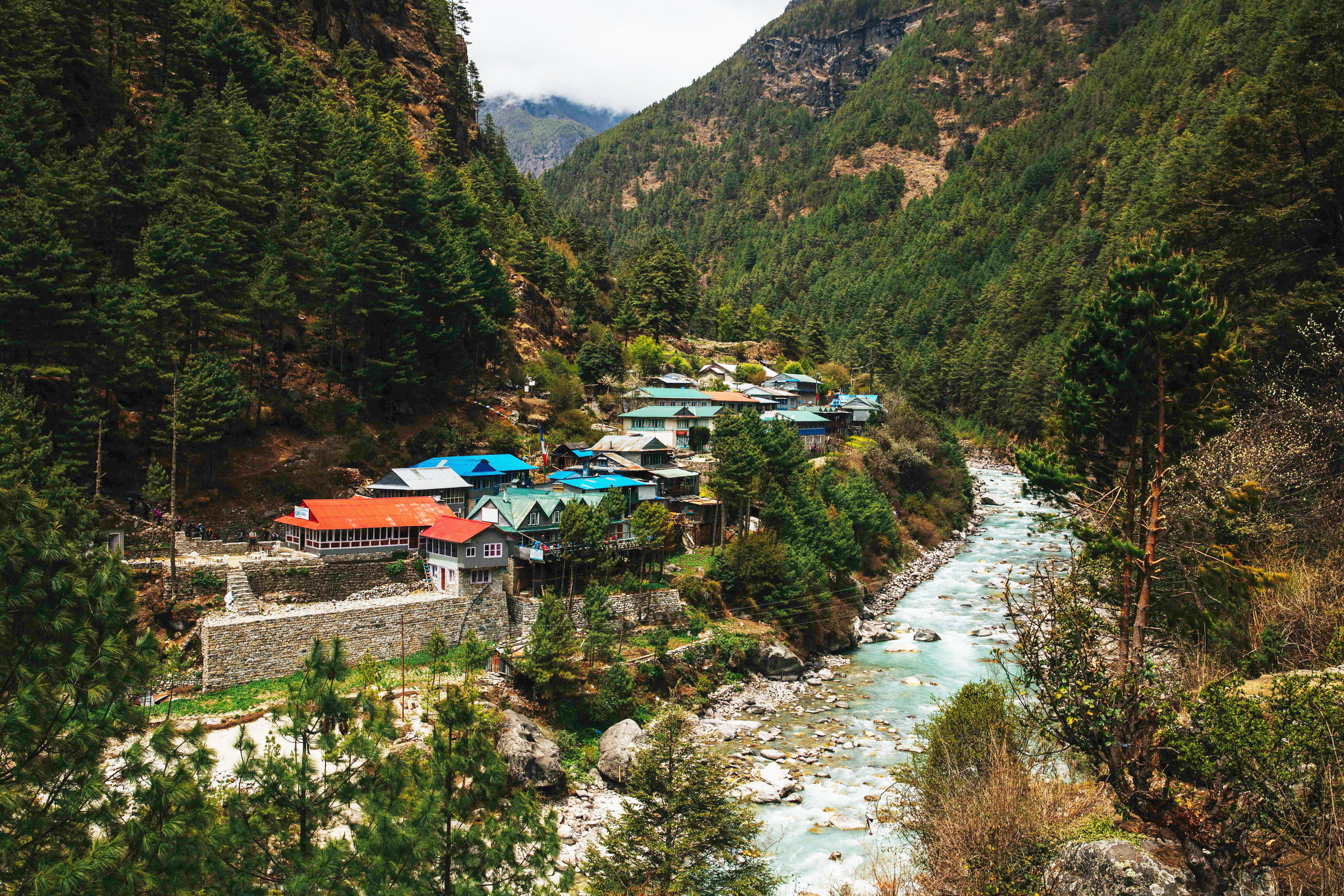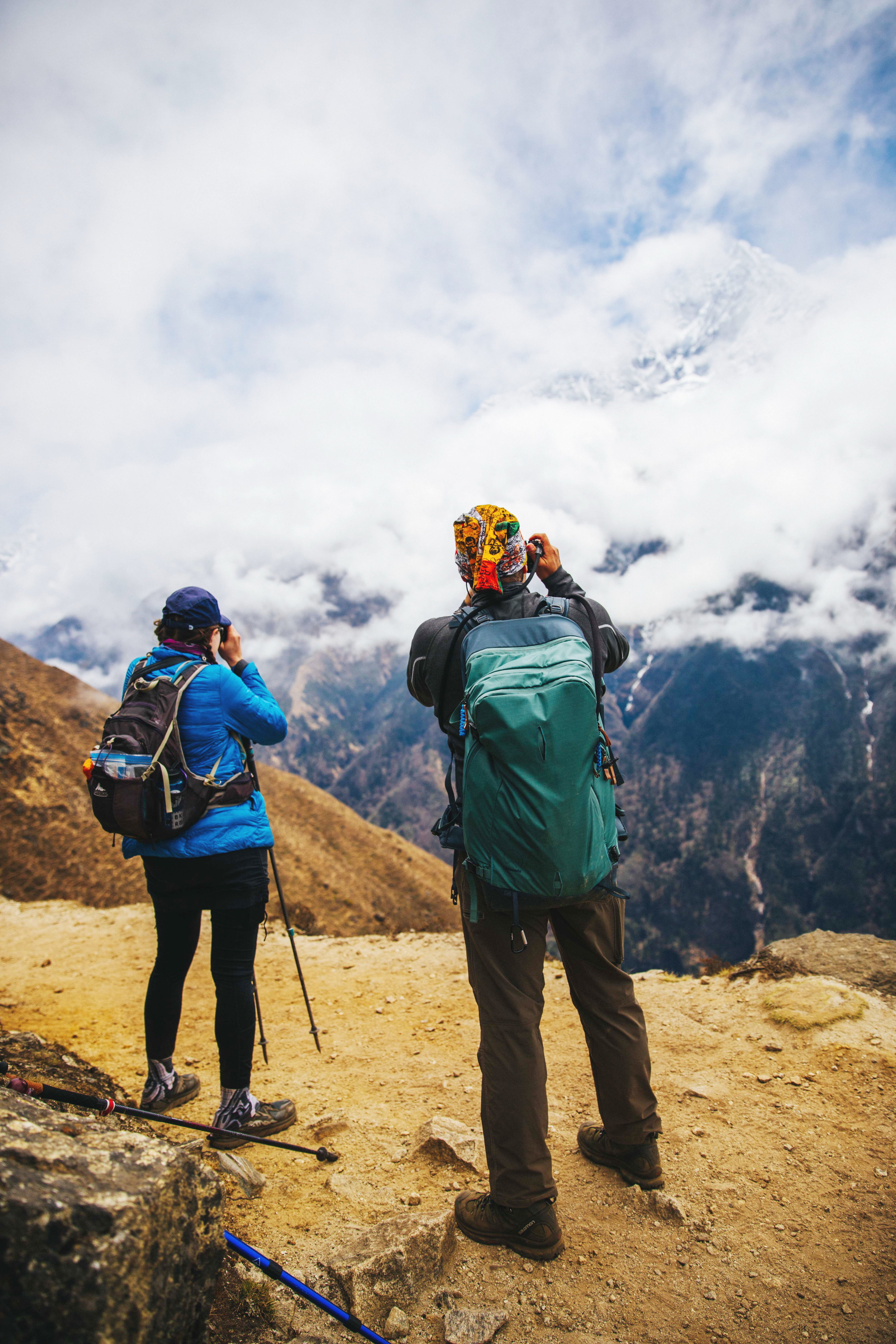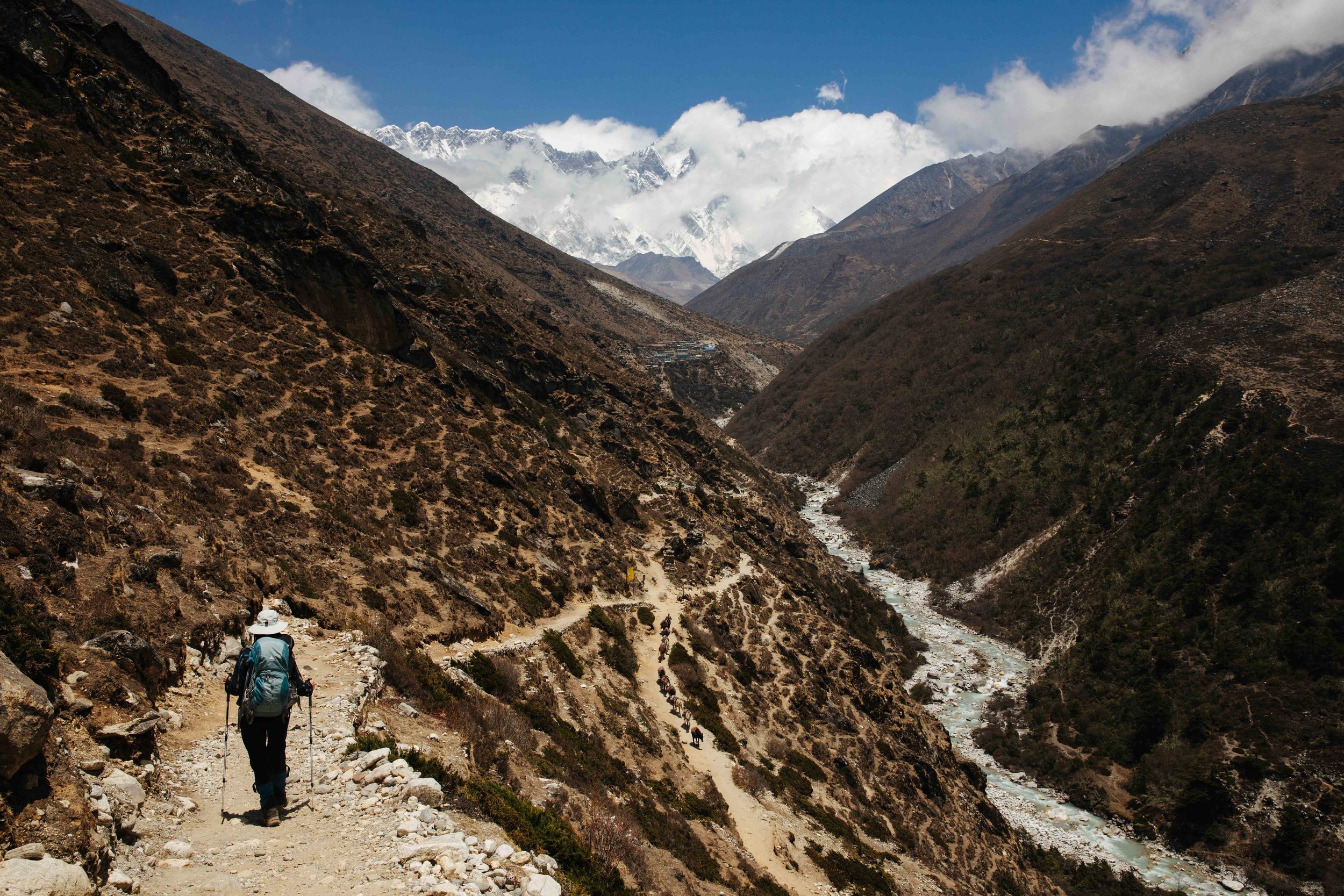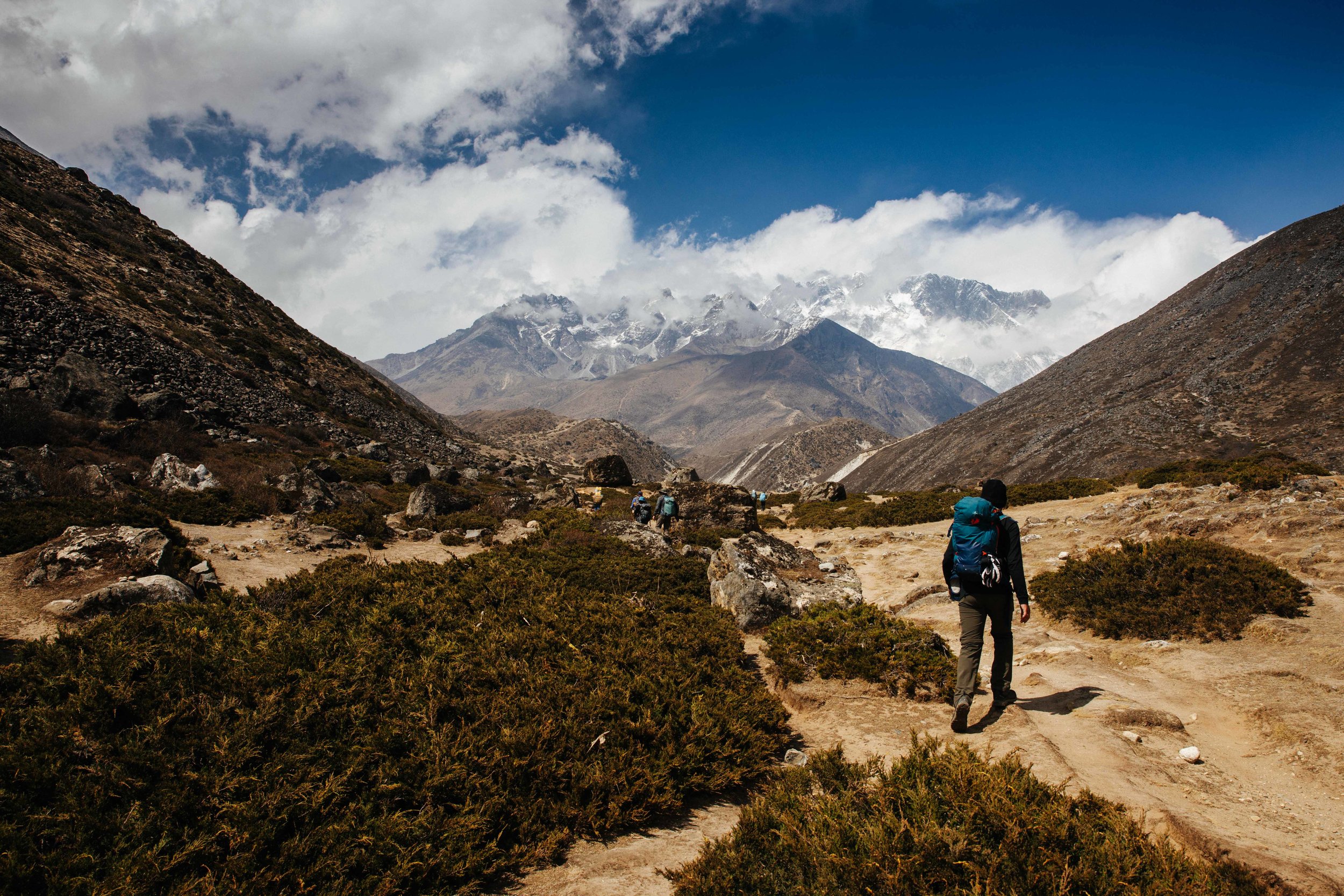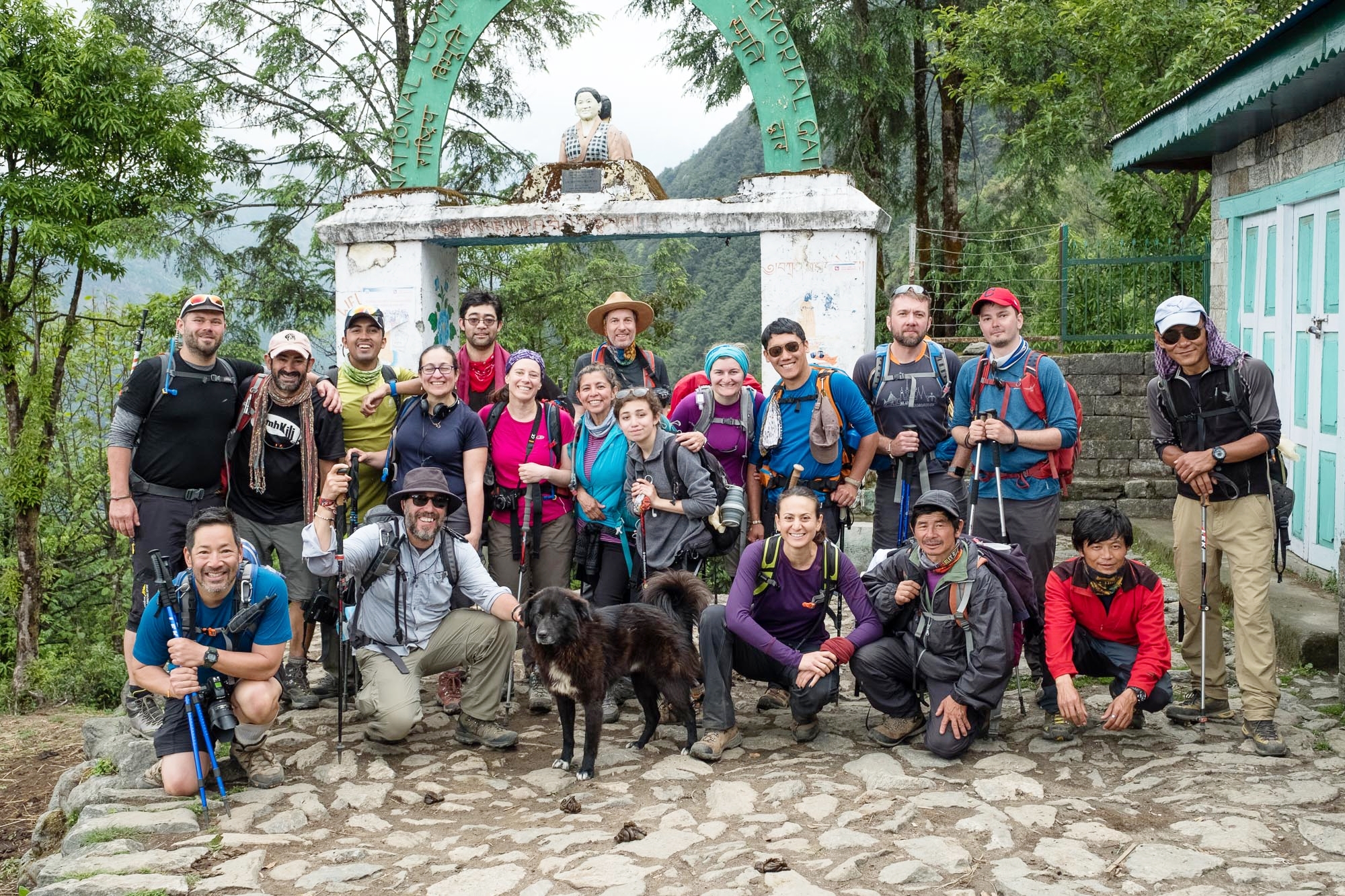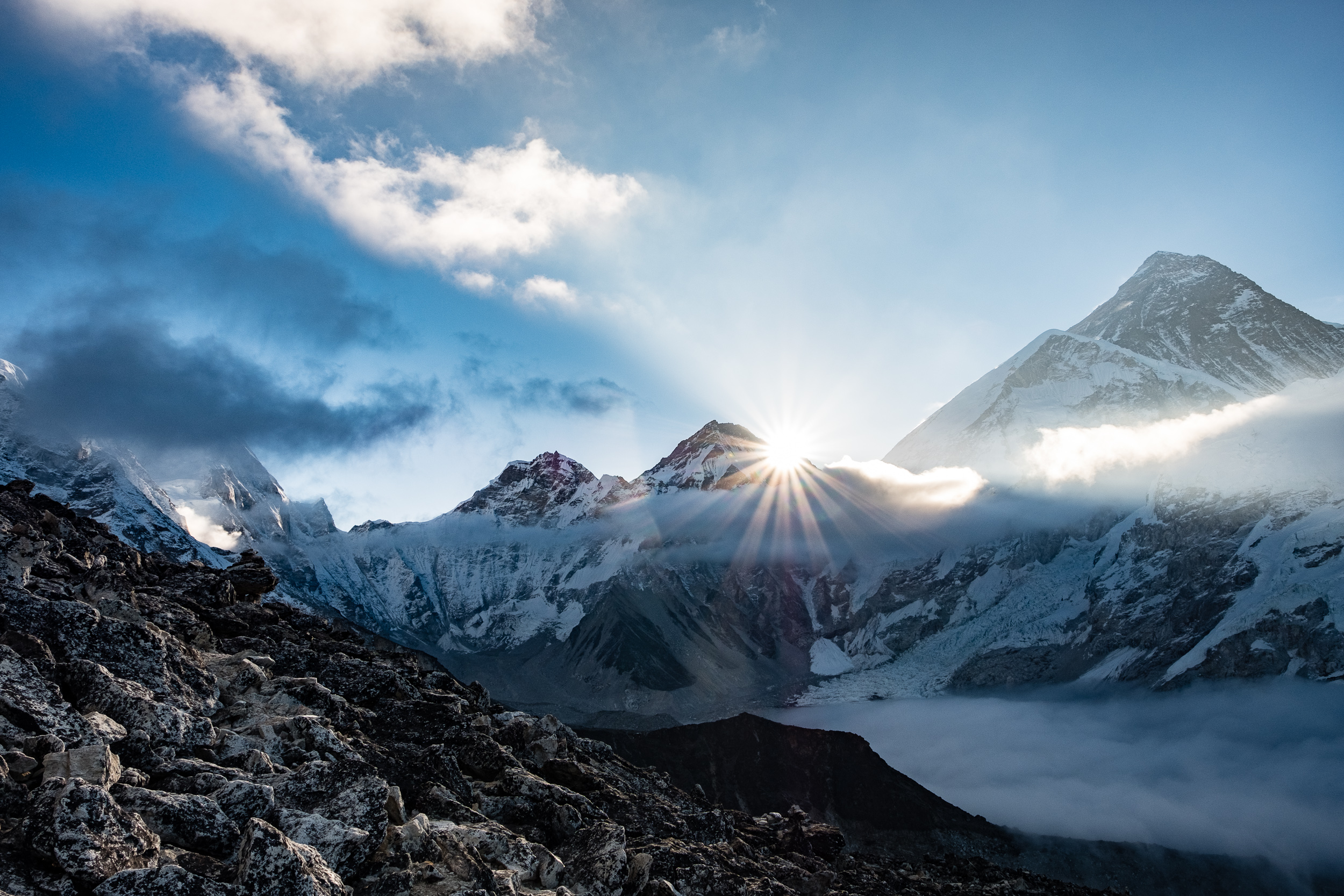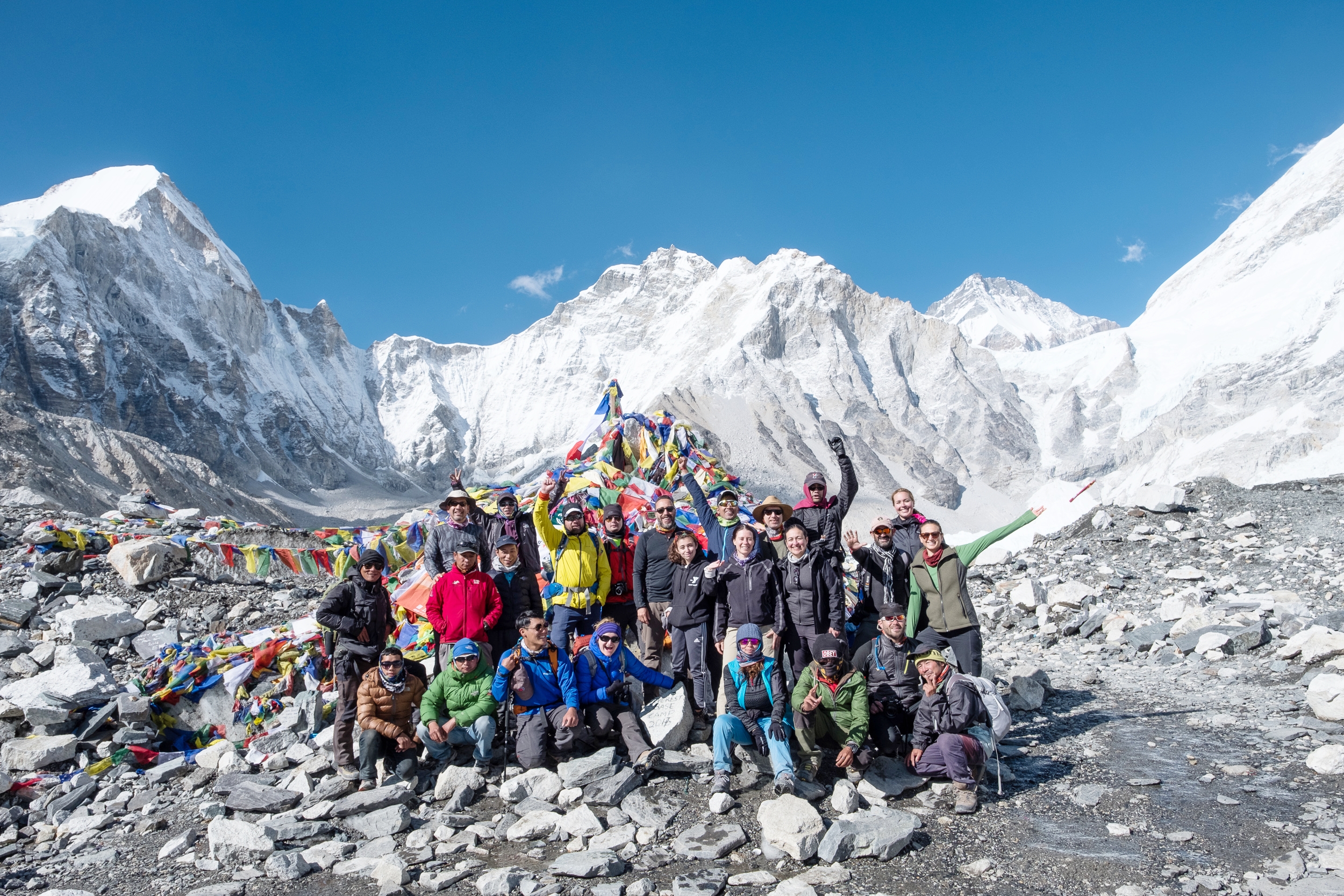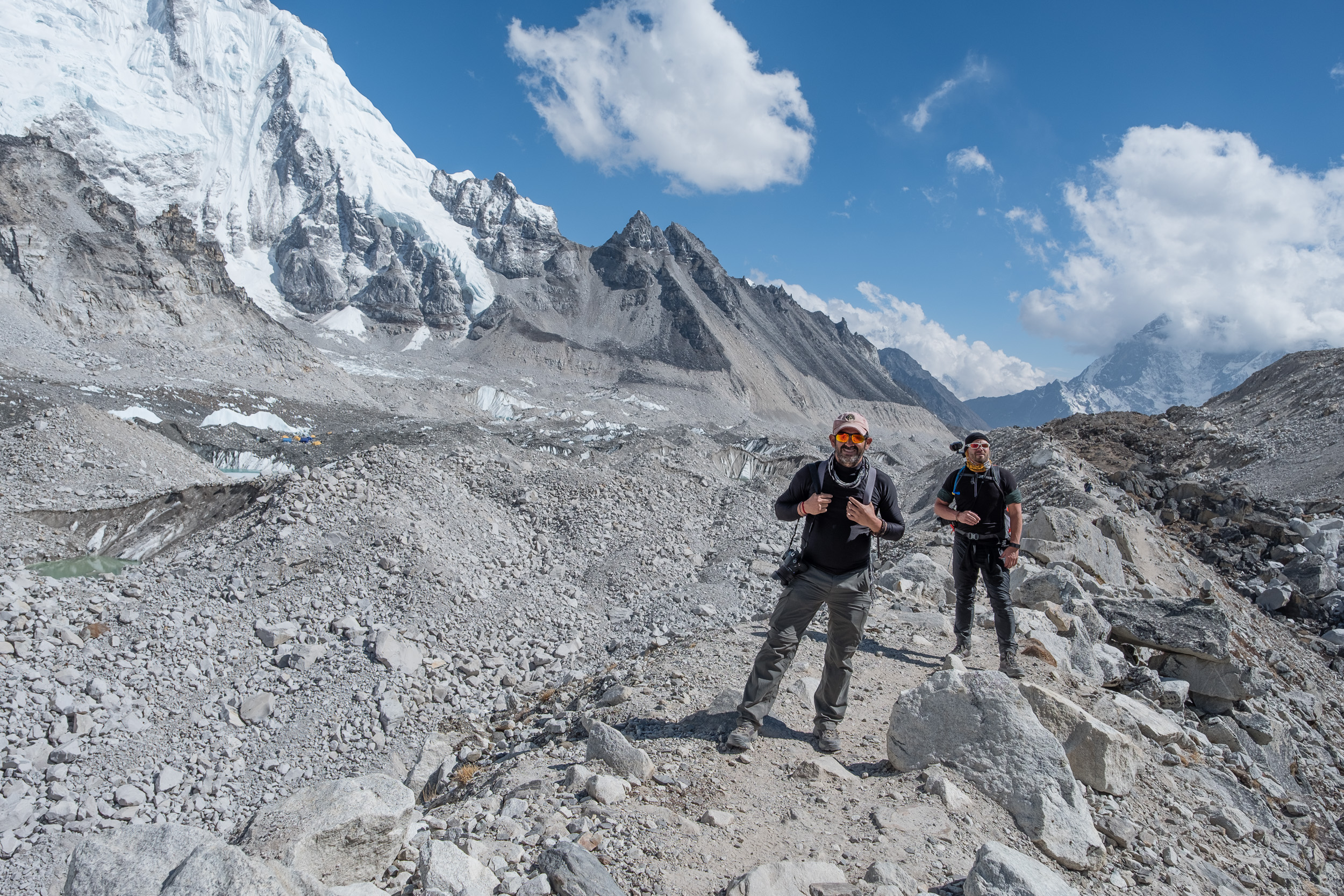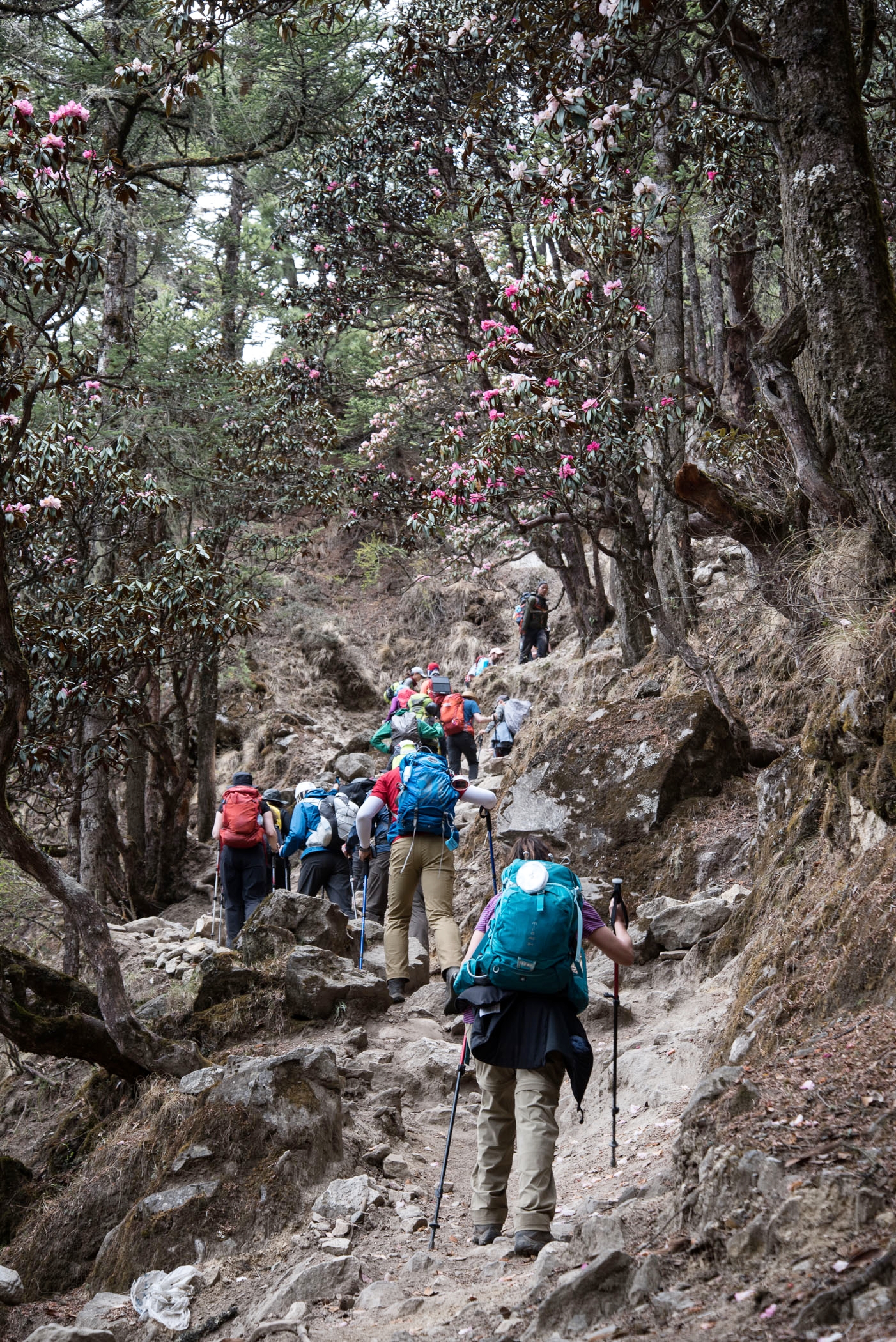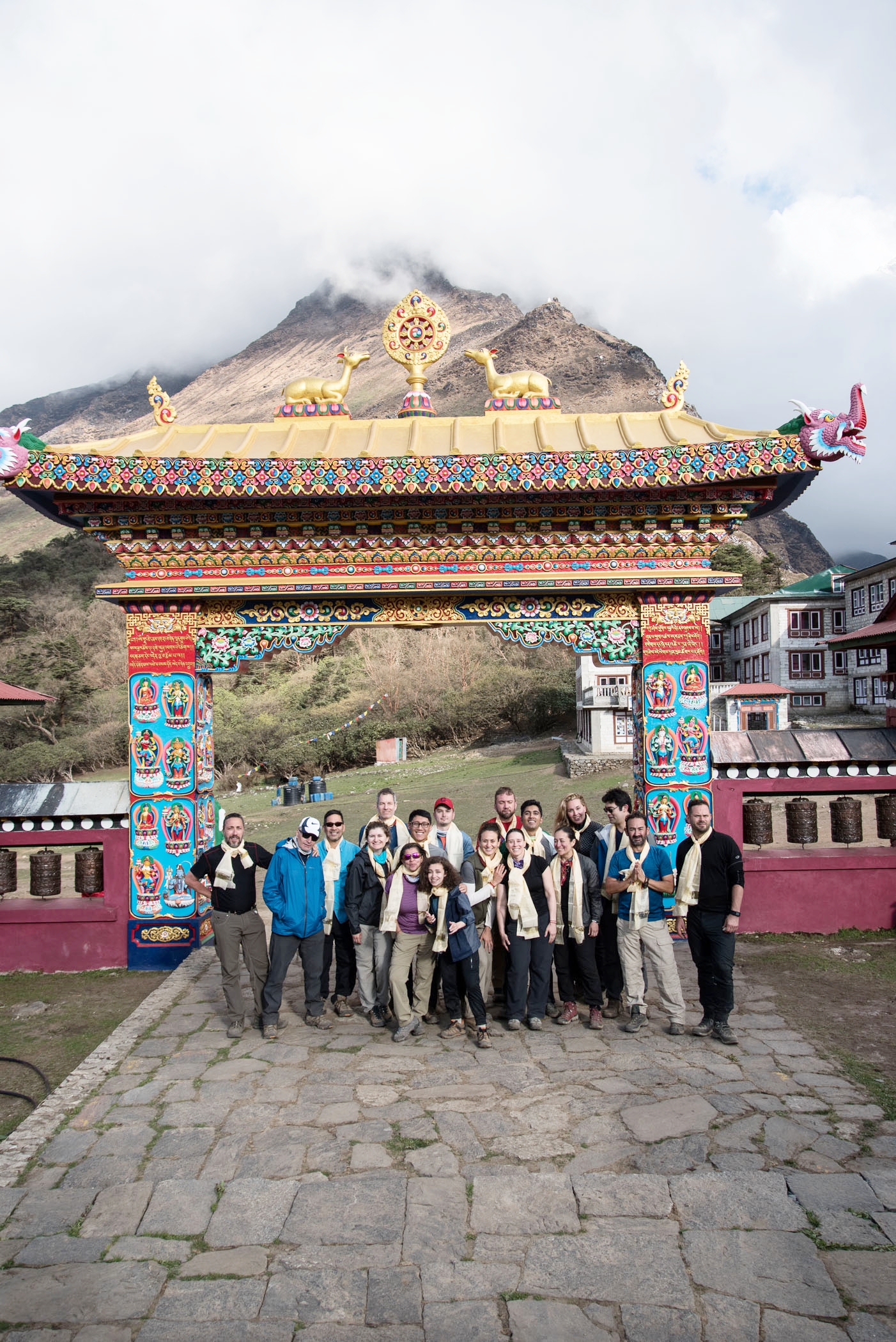Everest Base Camp Trek and mountain helicopter Nepal Spring/Fall 2024/2025


Everest Base Camp Trek and mountain helicopter Nepal Spring/Fall 2024/2025
Trek to Everest Base Camp via Gokyo Lakes on one of the most scenic trails in the world. We take the less traveled route to basecamp, hiking through Sherpa villages, rhododendron forests and over mountain passes with panoramic views of the Himalayas above and valleys and rivers below. We spend a full day taking in the stunning, turquoise, glacial lakes of Gokyo, the highest freshwater lakes in the world. After visiting Everest Base Camp and climbing Kala Patthar, we take a helicopter ride back to Kathmandu. In the sky, we will enjoy breathtaking views of the mountains up close and personal.
PRICE TBD
The Everest Base Camp Trek takes one to the foothills of the mightiest of the mountains in the world. En route, traverse from temperate to snow line regions, through rhododendron and pine forests, Sherpa villages and Buddhist Monasteries. Cross valleys surrounded by white peaked mountains and trek along turquoise glacial rivers and lakes.
This is one of the more adventurous treks in the Everest Himalayas. The ascent follows the Dudh Koshi and Khumbu valleys from the homeland of the Sherpa people to the Gokyo valley, which provides breath-taking views of three 8,000m peaks; Everest, Cho Oyu, Makalu and the largest glacier in Nepal, the Ngozumpa glacier. We visit the turquoise Gokyo lakes before heading towards Everest Base Camp.
Photographic Opportunities
Before the trek, we will be visiting the cultural centers of Nepal in Kathmandu. That will give us the opportunity to photograph some of Nepal's ancient architecture as well as the Nepali people as they go through their daily, and religious lives. On the trek, we will be passing through mountain villages and Monasteries with ample time to photograph. The landscape along the trek is second to none. We will explore landscape and night sky photography.
What's included
All transfers, sightseeing tours and drives as per itinerary in a private tourist vehicle accompanied by an English speaking guide from Himalayan Holidays.
4 nights stay at hotel (as above) in Kathmandu on twin sharing basis including American breakfast and all taxes.
Nepali Welcoming Dinner at a Nepali authentic restaurant in Kathmandu.
Tea House Trek as per Itinerary including all meals, accommodation at Lodges and Tea Houses, and the service of an English speaking trek leader and a team of experienced Sherpa assistant/s and reliable porters.
Sightseeing tours as per itinerary including applicable entry fees
Sagarmatha National Park fees.
Helicopter return to Kathmandu from Pangbouche. Cutting the return trek by 2 days and avoiding the weather issues that plague Lukla Airport with frequent delays.
What's not included
International airfares and airport departure taxes.
Nepal entry visa (US$40 per person).
Items of a personal nature such as; laundry, bar bills, alcoholic beverages (except on welcome dinner), extra mileage, optional tours such as Mountain Flights, telephone calls, internet services, personal gratuities such as tips to guides, bell-hops or hotel porters, drivers, etc.
Comprehensive Travel Insurance or “Umbrella Insurance” to cover – Illness, hospitalization, travel medicines, loss of valuables, thefts, change of itinerary, flight and tour cancellations due to unavoidable circumstances and most of all Emergency Helicopter Charter for evacuation purpose.
Any items that are not mentioned in the above What's Included section.
Details, and timing are subject to change due to conditions on the ground.
Faqs: Click on + for answer
+ How hard is the trek
The trek is lots and lots of up and down walking. The better shape you are in the easier it is. A person of regular fitness can accomplish this trek. Although a better experince if you are in good shape. It is recommended that you start training doing cardio excercises and build up the strength of your legs.
+ Are there any phyisical restrictions
Yes, you must be of good health with no major health issues. We will be at very high altitudes which can aggravate any medical conditions. A visit to your doctor before you decide on going is mandatory.
+ Will I need any specialized gear
You will need the basics of hiking gear as well as some specialized gear. Some gear like sleeping bags can be rented in Kathamndu at a very resonable price. A packing list of the basics will be provided once you have signed up.
+ How much money should I bring
While credit cards are accepted in some places in Khatmandu, cash is preferable. There are ATM machines in Khatmandu but you may have to try a few before finding one that will work with your card. It is recommended you bring cash and change it at the airpoort.
There are no ATMs and credit cards are not accepted on the trek. You will need cash on the trek to tip the guides and porters and if you want to buy snacks or memoribilia along the way. In the mountain towns, there are people selling locally made crafts as well as practical things such as sun hats and booties and most importantly, Snickers bars.
If you want to do something not on the schedule, you will need extra cash, also bring cash for drinks, tips for the guides, and some meals in Kathmandu. There are some good shopping opportunities in Kathamndu.
+ Food/water availability? Types of food?
On the trek meals will be provided. It can get pretty basic, particularly as you get to the higher altitudes. CV is working on making the food more interesting. It’s mostly Indian type food. As for water on the trail. We can’t bring bottled water up the whole way. Plus we have serious issues with the use of disposablle plastic water bottles. Filtered water will be provided every morning for everyone to drink and carry with them for the day. We recommend water treatment tablets to treat the water. Also very important, you should bring snacks like cliff bars, beef jerky, snickers bars etc
Itinerary: click on + for detailed schedule
+ Day 01 / Arrival in Kathmandu
Upon arrival in Katmandu’s Tribhuvan International Airport, CV will meet you, provide any needed assistance and transfer you to the hotel. After welcome refreshments and room check in the hotel, there will be a short briefing and orientation about the trip. Rest of the day is free for leisure. Overnight at hotel.
+ Day 02 / Kathmandu monuments
After breakfast, proceed for a sightseeing tour of Kathmandu City. It includes a visit to the Hanuman Dhoka (Kathmandu Durbar Square) - an ancient durbar (palace) with its numerous old palaces, temples and pagodas, the Temple of Living Goddess “Kumari”, and the Kasthamandap Temple, which is believed to be constructed from the wood of a single tree from which Kathmandu derives its name. Next we visit the Boudhanath Stupa - an ancient colossal stupa and the center of Tibetan Buddhism in the world and the Pashupatinath Temple- the Temple of Lord Shiva situated on the bank of the holy Bagmati River. After lunch drive up to the Swayambhunath Stupa situated atop a hill from where you could get a bird’s eye view of Kathmandu Valley. The Swayambhunath Stupa is also known as the “Monkey Temple”.
In the evening, we will have a trip briefing followed by a welcome dinner at an Authentic Nepali restaurant with cultural program.
+ Day 03 / Fly To Lukla & start Trek to Phakding (2,652m / 8,700 ft.) ~3 hrs
Early morning transfer to the airport to fly to Lukla (2,880m). This 45-minute flight provides a magnificent entry to the trek. It highlights the snow line of the Himalayan Range in the north and the rugged landing at the Lukla airport, which is said to be one of the most spectacular flights in the world. Upon arrival the guide will arrange the porters at the nearby lodge. During this break, the guests are welcome to explore this bustling town on top of a hill with rows of houses, hotels and shops lining both sides of the traditional cobbled street.
The trek starts by following the trail leading to the northwest direction through the narrow street, which immediately descends from the end of the village on a trail through the open hillside. The trail is well defined and there are many shops and lodges catering to the trekkers. This day’s trek is an easy one and ultimately descends to the river at Phakding (2,652m). Dinner and overnight at teahouse lodge.
+ Day 04 / Trek to Namche Bazaar (3,447m / 11,300 ft) 5~6 hrs
Leave the main village and follow the trail on the left bank of the Dudh Kosi River. It is a pleasant walk for the first half of the day as one passes through agricultural countryside and small wayside villages. Just before lunch, there is a steep climb of about 20 minutes to arrive at Monjo for Lunch. After lunch, trek up to the check post to check the permits and enter into the Sagarmatha National Park. Descend for 10 minute and then cross a suspension bridge to arrive at Jorsale (2,800m). Pass through several small villages and beautiful pine forestsa. This is a busy trail with plenty to see. Our first good views are of west ridge of KusumKangru (6,339m). Follow the Dudh Kosi River, crossing a suspension bridge, and then slowly climb up a very steep trail to Namche Bazaar. Near the halfway point, we enjoy our first views of Mt. Everest (8,848m), Nuptse (7,879m) and Lhotse (8,383m) - the big three. The climb is for nearly 3 hours as one gains in altitude making breathing difficult due to rarified air. Arrive at a gate with a sign saying, "Welcome to Namche Bazaar" but it is very misleading as it takes another 20 minutes to arrive at the main town. This prosperous town is the largest in Khumbu. Mt. Thamserku (6,648 m) and KwangdeRi (6,624 m) loom along the east and west of the village. The sacred mountain Khumbila (5,707 m) dominates the skyline along the west. Dinner and overnight at teahouse lodge.
+ Day 05 / Acclimatization day in Namche Bazaar
In the morning after breakfast go for a walk and later return for lunch. After lunch the guests are free to rest or go around the bustling Namche Bazaar. Dinner and overnight at teahouse lodge.
+ Day 06 / Trek to Thame (3820m / 12,533 ft) 4~5 hrs
Traverse westward with view of Kwangde (6343 m) and the waterfall cascading off its flanks. Follow Bhote Kosi as the side hills high on its bank through the red and yellow rhododendron forest (in full blossom in May). Cross the river and look down the valley for views of Thamserku (6648m) and Kusum Kanguru (6370m). Climb up to Thame village through the forest. It is a secluded village and the birthplace of Tenzing Norgay the first Sherpa to climb the Mount Everest. Dinner and overnight at tea house lodge.
+ Day 07 / Trek to Lungden (4380m / 14,370 ft) 4~5 hrs
Today we start our serious high altitude trekking. We walk for about 4 hours through a stunning landscape on an old trade route to Tibet to the village of Lungden. This village has only one lodge and very aptly called the Renjo La Support Lodge. Dinner and overnight at tea house lodge.
+ Day 08 / Trek to Gokyo (4750m / 15,584 ft) via Renjola Pass (5430m / 17,815 ft) 8~9 hrs
The big day starts real early and it is a long day, as we have to walk about 6 hours to reach the pass, going slow because of the high altitude. After a brief stopover to enjoy the stunning beauty of the Everest Range and photographs, we start on a remarkably difficult downhill journey for about 3 hours to reach the village of Gokyo. We walk along the stunning and beautiful Dudh Kunda river. Dinner and overnight at lodge in Gokyo.
+ Day 09 / May 28 Explore around Gokyo Lakes
After breakfast trek to Gokyo Fifth Lake which offers excellent views of Everest and Cho Oyu. Later return back to hotel for rest. Dinner and overnight at tea house lodge.
+Day 10 / Trek to Phortse Tanga (3,680m / 12,073 ft) via Macchhermo and Dole ~7 hrs
After breakfast it is about a two hour gradual walk to Machhermo. After Machhermo continue trek to Luza. Form Luza it is about half an hour steady descent down to the village Dole. After lunch in Dole continue descent down to Phortse Tanga. The descent is steeply out of the valley through rhododendron and oak forests. Dinner and overnight at tea house lodge.
+ Day 11 / Trek to Pheriche (4,220m / 13,840 ft) via Phortse & Pangboche 7~8 hrs
After breakfast, start climb towards Phortse Village – The largest Sherpa Village in the Everest Region. Continue walk through slopy area towards Pangboche on the way you can see the many Yaks grazing around and you can also witness the beautiful view of Thyangboche Monastery & Mt. Amadablam. Stop in Phangboche for hearty lunch. From here next half an hour the path is on level ground with few gentle climbs. We have to go uphill for about 45 minutes to reach Somare. From here the trails goes up to the left, through the front yards of a few herders’ huts, over a stone wall and climbs a small ridge before descending to Khumbu Khola, crossing it on a metal bridge. After crossing bridge it is about 10-mins walk to Pheriche, which is a windier place and is colder than most places in Khumbu. Dinner and overnight at Tea house lodge in Pheriche.
+ Day 12 / Trek to Lobuche (4,931m / 16,173 ft) via Phortse & Pangboche 7~8 hrs
Traverse across the open landscape with a short steep ascent to arrive at a ridge to join the main trail coming up from Dingboche on the right and the trail from Cho la pass on the left. On the way you can watch the beautiful view of the Mt. Cholatese (6,442m) back on the westside of the route and Mt. Amadablam to the rear. After arrival at the ridge, descend, for about ten minutes, cross a bridge and arrive at Thugla for a short break. After Thugla, there is a very steep ascent for about one hour to the ridge where there is a Sherpa memorial in remembrance to those brave mountaineers who died during Expeditions. Travel along the jumbled moraines and scattered rocks passing by the memorials of Rob Hall and Yasuko Namba and others who perished during the Mt. Everest disaster of 1996. The memorial chortens dot the skyline facing the mountains and overlooking the valley below. Further on, the trail leads to the terminal moraine of the Khumbu Glacier with views of Pumori, or Widow’s Peak, in the foreground. The stark and rugged beauty creates almost a moonscape. After another hour of steady trekking through the moraine, the teahouse at Lobuche is reached for lunch. It is situated in a windswept valley with views of the Tawatse (6,501m) and Nuptse (7,855m). Dinner and overnight at teahouse lodge.
+ Day 13 / Trek to Gorakshep (5,160m / 16,925 ft) & continue to Everest Base Camp (5,360m / 17,580 ft) ~7 hrs
After breakfast continue trekking along the Khumbu Glacier through the jumbled moraines and scattered rocks. The trail continues to slowly contour on the open landscape through an ablation and after about an hour, there is a steep ascent for about 20 minutes. Climb slowly to a ridge and then continue on a trail of rocks caused by rockslides. On a clear day Mt. Everest can be seen looming behind Nuptse. Arrive at the ridge above Gorakshep and then descend to Gorakshep, a settlement with a few teahouses for overnight. This was the base camp for the 1952 Swiss Everest expedition. In 1953, the British Everest expedition called this “lake camp’. Gorekshep or "graveyard of the crows” has a small lake that is usually frozen and several monuments to climbers who have died during various Everest expeditions. The carved stone in memory of Jake Britenbach, US expedition and the monument of Indian Ambassador H. Dayal, who died during a visit to Everest Base Camp after the 1965 Indian expedition, are northeast of the lake
After lunch in Gorakshep, trek to Everest Base Camp. The trip to base camp, while fascinating, is not as spectacular as the ascent of Kala Pattar because there is no view of Everest itself from base camp. Mt. Lhotse and Mt. Nuptse, which loom over base camp, shades the view of Everest. The trail continues on a ridge from where a small glimpse of Mt. Everest can be seen. At the end of the ridge, a scrabbling descent leads to the entry onto Khumbu Glacier. The trail through the glacier is an interesting one in that one can actually feel as if one is inside a fridge with the cold seeping from all sides. The Everest Base Camp is also base camp for Lhotse and Nuptse. It is not actually a specific site as various expeditions have elected different locations for a semi-permanent camp during their assault on the mountains. Some of the sites that expeditions have used as base camps are identifiable from debris on the glacier at 5360m or more. After visiting base camp, backtrack to Gorakshep. Dinner and overnight at teahouse lodge.
+ Day 14 / Climb Kala Patthar (5545m / 18,187 ft) & back to Pangboche 8~9 hrs
Very early in the morning keep your backpacks in the lodge and take the left-hand side trail and head straight up the hill to Kala Pattar (5,545m) for views of Mt. Everest. The trek up to the top is an arduous one and takes about an hour and half to two to reach it. The afternoon is the best time to view Mt. Everest from this vantage point as the sun is behind the observer and directly on the mountains in front. The climb to the Kala Patthar though tough, is well worth it as the views from here are breathtaking. The giants of the earth are all around Pumori (7,145m), Everest (8,848m), and China’s peak Changtse (7,553m), Nuptse (7,855m), Lhotse (8,516m), Ama Dablam and many others. Return to Gorakshep for breakfast.
After breakfast start descending down to Pheriche for lunch and continue further to Pangboche for overnight.
Dinner and overnight at teahouse lodge.
+ Day 15 / Fly to Kathmandu by Charter Helicopter
After early breakfast, walk to nearby Helipad to board the Charter flight to Kathmandu. Upon arrival in Kathmandu transfer to hotel for room check in and rest. Rest of the day is for leisure. Dinner and overnight at hotel.

